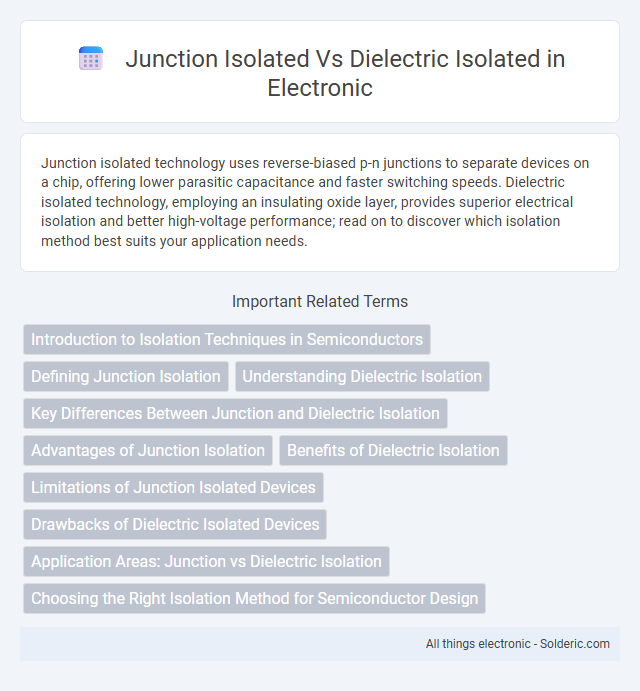Junction isolated technology uses reverse-biased p-n junctions to separate devices on a chip, offering lower parasitic capacitance and faster switching speeds. Dielectric isolated technology, employing an insulating oxide layer, provides superior electrical isolation and better high-voltage performance; read on to discover which isolation method best suits your application needs.
Comparison Table
| Feature | Junction Isolated | Dielectric Isolated |
|---|---|---|
| Isolation Method | PN junction isolation | Silicon dioxide (SiO2) dielectric isolation |
| Isolation Quality | Moderate, susceptible to leakage currents | High, superior electrical isolation |
| Substrate Type | P-type or N-type silicon | Typically SOI (Silicon on Insulator) wafers |
| Parasitic Capacitance | Higher parasitic capacitance due to junctions | Lower parasitic capacitance with dielectric barriers |
| Power Consumption | Higher leakage currents increase power | Lower leakage currents reduce power consumption |
| Complexity & Cost | Simpler and less expensive | More complex fabrication, higher cost |
| Applications | Standard analog/digital ICs where cost is critical | High-performance, low-noise, RF, and microwave ICs |
| Thermal Conductivity | Better heat dissipation through substrate | Reduced thermal conductivity due to SiO2 isolation |
Introduction to Isolation Techniques in Semiconductors
Junction isolated and dielectric isolated techniques are essential semiconductor isolation methods that prevent electrical interference between devices on an integrated circuit. Junction isolation uses reverse-biased p-n junctions to create barriers, while dielectric isolation employs insulating materials like silicon dioxide to electrically separate components. Your choice of isolation method impacts device performance, leakage currents, and fabrication complexity in semiconductor manufacturing.
Defining Junction Isolation
Junction isolation uses reverse-biased p-n junctions to electrically separate devices on a semiconductor chip, creating isolated regions by surrounding active components with a barrier that prevents current flow. This technique contrasts with dielectric isolation, which physically separates devices using an insulating material like silicon dioxide, offering superior isolation but at increased fabrication complexity. By understanding junction isolation, you can optimize your circuit design for cost-effective integration and adequate device separation in standard CMOS processes.
Understanding Dielectric Isolation
Dielectric isolation separates devices by embedding them in an insulating material like silicon dioxide, preventing electrical interaction between components and reducing parasitic capacitance. This method offers superior electrical isolation compared to junction isolation, which relies on reverse-biased p-n junctions to isolate devices within the same semiconductor substrate. Dielectric isolation enhances device performance in integrated circuits by minimizing leakage currents and allowing higher packing density for analog and mixed-signal applications.
Key Differences Between Junction and Dielectric Isolation
Junction isolation uses reverse-biased p-n junctions to electrically separate devices on a chip, leveraging semiconductor doping techniques, while dielectric isolation employs insulating materials, such as silicon dioxide or glass, to physically and electrically isolate components. Junction isolation typically offers lower fabrication complexity and cost but may suffer from higher parasitic capacitance and latch-up risks, whereas dielectric isolation provides superior electrical isolation and reduced parasitic effects at the expense of more complex and expensive manufacturing processes. Dielectric isolation is crucial in high-performance analog and RF integrated circuits, where minimizing interference and leakage currents is essential.
Advantages of Junction Isolation
Junction isolation offers advantages such as reduced parasitic capacitance and improved device density compared to dielectric isolation, enabling faster switching speeds in integrated circuits. This technique provides better electrical isolation by using reverse-biased p-n junctions, which minimizes leakage currents and enhances reliability in mixed-signal and analog applications. You benefit from junction isolation's cost-effectiveness and compatibility with standard semiconductor fabrication processes, making it ideal for high-performance and high-volume production.
Benefits of Dielectric Isolation
Dielectric isolation offers superior electrical insulation by separating semiconductor devices with a non-conductive material, significantly reducing parasitic capacitance and leakage currents compared to junction isolation. This isolation technique enhances device performance in high-frequency and high-voltage applications by minimizing electrical interference and improving signal integrity. Furthermore, dielectric isolation provides better resistance to latch-up and allows for higher device packing density, leading to more reliable and compact integrated circuits.
Limitations of Junction Isolated Devices
Junction isolated devices face limitations such as higher parasitic capacitance and leakage currents due to the use of PN junctions for isolation, which can degrade performance at high frequencies. Their susceptibility to latch-up and limited voltage isolation restricts their application in high voltage or high-speed circuits. To ensure reliable operation in sensitive or demanding environments, your design might benefit more from dielectric isolated devices offering superior electrical isolation and reduced interference.
Drawbacks of Dielectric Isolated Devices
Dielectric isolated devices often suffer from higher parasitic capacitance and increased fabrication complexity, leading to elevated manufacturing costs and reduced circuit density. The dielectric isolation process can introduce mechanical stress and thermal mismatch issues, which may degrade device reliability over time. These drawbacks limit their suitability for high-performance or high-frequency applications compared to junction isolated counterparts.
Application Areas: Junction vs Dielectric Isolation
Junction isolated technology is predominantly used in mixed-signal integrated circuits and analog applications where cost-effective isolation between components is required without significant area overhead. Dielectric isolated devices find extensive use in high-voltage, radio frequency, and precision analog circuits due to their superior isolation properties and reduced parasitic capacitance. The choice between junction and dielectric isolation significantly impacts system performance in power management, RF modules, and sensor interfaces.
Choosing the Right Isolation Method for Semiconductor Design
Junction isolated and dielectric isolated methods offer distinct advantages depending on your semiconductor design requirements; junction isolation uses reverse-biased p-n junctions to separate devices, providing cost-effective isolation with moderate parasitic capacitance. Dielectric isolation employs an insulating oxide layer, delivering superior isolation, reduced device interaction, and improved high-frequency performance, albeit at a higher manufacturing complexity and cost. Selecting the right isolation technique hinges on balancing factors like device density, frequency response, and fabrication budget to optimize your design's efficiency and reliability.
Junction isolated vs Dielectric isolated Infographic

 solderic.com
solderic.com